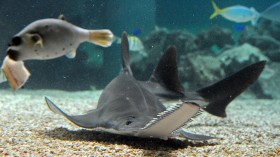Initial experiments of soil by NASA's Mars rover Curiosity has shown similarities between minerals in the Martian soil and the weathered basaltic soils of the volcanic origin in Hawaii.
Curiosity's Chemistry and Mineralogy instrument (CheMin) used X-ray diffraction method to study the internal structure of the minerals in the soil. This is the first time, an X-ray diffraction analysis has been performed on Mars.
"We had many previous inferences and discussions about the mineralogy of Martian soil," principal investigator for CheMin David Blake, from NASA Ames Research Center in Moffett Field, Calif., said in a statement.
"Our quantitative results provide refined and in some cases new identifications of the minerals in this first X-ray diffraction analysis on Mars," he said.
The analysis of minerals in rocks and soil plays a significant role to assess previous environmental conditions. The minerals record the conditions in which they were formed. This could help the scientists to find out if the red planet could have supported microbial life.
The samples for the first analysis were taken from a site known as Rocknest. While the first scoop of soil was used to clean the internal surfaces of the rover's sample processing chambers, the second scoop was discarded, the third and fourth scoop were delivered to the CheMin and another instrument called sample analysis at Mars (SAM) to determine the chemical and mineral composition of the soil.
The samples sent to the CheMin instrument were processed through a sieve to remove particles larger than 0.006 inch. The soil samples were mineralogically similar to basaltic material found in Hawaii.
"We now know it is mineralogically similar to basaltic material, with significant amounts of feldspar, pyroxene and olivine, which was not unexpected. Roughly half the soil is non-crystalline material, such as volcanic glass or products from weathering of the glass," said David Bish, CheMin co-investigator with Indiana University in Bloomington.
Weathering of soil components on Mars could be the result of an interaction with water or oxygen, just like how rust forms on iron materials. Sandstorms and meteorite impact could also cause the elements of the soil to weather, said chemist Douglas Ming of NASA's Johnson Space Center in Houston, according to a Reuters report.
Curiosity is on a two-year mission on Mars to find if there was a habitable environment. The rover is currently located at Rocknest and will later head to Glenelg, where three different terrains intersect. It will spend about a month before heading to its ultimate destination - Mount Sharp. It will take at least a year for the rover to reach Mount Sharp, where the composition of sand is different.
© 2024 NatureWorldNews.com All rights reserved. Do not reproduce without permission.
![Severe Thunderstorm Alert: Tornadoes, Damaging Winds and Hail Possible from Upper Ohio Valley to Northeast US [NWS]](https://1471793142.rsc.cdn77.org/data/thumbs/full/70161/280/157/50/40/severe-thunderstorm-alert-tornadoes-damaging-winds-and-hail-possible-from-upper-ohio-valley-to-northeast-us-nws.jpg)




